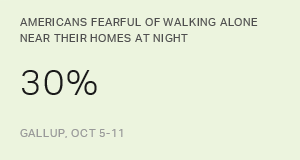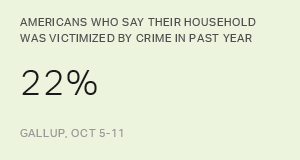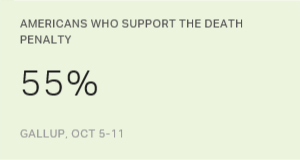Story Highlights
- Fear of walking alone was as high as 48% in 1982
- Americans' worry about 11 different crimes generally stable since 2001
- Slightly less worry now about home burglary and terrorism
WASHINGTON, D.C. -- Three in 10 Americans are afraid to walk alone at night in an area within a mile of where they live. This ties the lowest level of concern since Gallup first asked this question in 1965 and is substantially below the high point of 48% recorded in 1982.
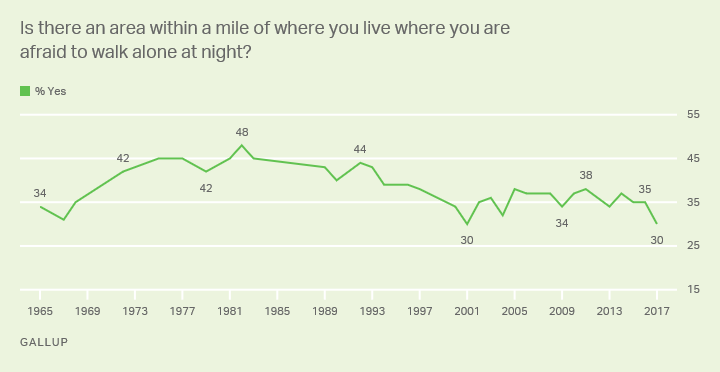
The average level of worry about walking alone at night since 1965 is 38%. This year's 30% worry level matches the previous low reading in October 2001. At that time, about a month after the 9/11 terrorist attacks, Americans may have felt safer from conventional crime and a bit more positive about local public safety efforts, or perhaps less willing to admit fear.
Americans were most likely to express worry about walking alone at night from 1972 to 1993 -- when 40% or more of U.S. adults consistently said they were worried, including the 48% high point in 1982. Concern began to fade in the mid-1990s and has not exceeded 40% since 1993. The drop in worry about walking alone since the early 1990s is coincident with national crime statistics indicating that U.S. crime rates have fallen since the early 1990s.
As has historically been the case, 18- to 29-year-olds, those with lower incomes, nonwhites and those living in big cities are most likely to fear walking alone at night near their home.
Some of the changes over time in worry about walking near home could reflect shifts in where people live or demographic changes in the population. Previous Gallup analysis has also shown that perceptions of safety near one's home can vary independently of views of the local crime rate.
About Four in 10 in Recent Years Worry About Home, Car Being Burglarized
Americans' levels of worry about a list of 11 crimes Gallup has tracked since 2001 have generally been stable, with these exceptions:
- Concern about being the victim of terrorism has dropped from 41% between 2001 and 2004 to 30% currently.
- About four in 10 are now worried about having their home burglarized when they are not there, down from 47% from 2005 to 2013; and there has been a similar drop in worry about one's home being burglarized when its occupants are there.
- Worry about being attacked while driving one's car, currently 20%, is lower in recent years than in the initial, 2001-2004, time period, when 25% worried about this occurring.
Otherwise, Americans' worry levels across this crime list have been quite constant over the past 16 years.
Americans continue to express the highest levels of concern about burglary when not home and car theft, and are least worried about sexual assault and being assaulted or killed by a coworker.
| 2001-2004 | 2005-2008 | 2009-2013 | 2014-2017 | ||||||||||||||||||||||||||||||||||||||||||||||||||||||||||||||||||||||||||||||||||||||||||||||||
|---|---|---|---|---|---|---|---|---|---|---|---|---|---|---|---|---|---|---|---|---|---|---|---|---|---|---|---|---|---|---|---|---|---|---|---|---|---|---|---|---|---|---|---|---|---|---|---|---|---|---|---|---|---|---|---|---|---|---|---|---|---|---|---|---|---|---|---|---|---|---|---|---|---|---|---|---|---|---|---|---|---|---|---|---|---|---|---|---|---|---|---|---|---|---|---|---|---|---|---|
| % | % | % | % | ||||||||||||||||||||||||||||||||||||||||||||||||||||||||||||||||||||||||||||||||||||||||||||||||
| Your home being burglarized when you are not there | 44 | 47 | 47 | 41 | |||||||||||||||||||||||||||||||||||||||||||||||||||||||||||||||||||||||||||||||||||||||||||||||
| Having your car stolen or broken into | 43 | 44 | 44 | 41 | |||||||||||||||||||||||||||||||||||||||||||||||||||||||||||||||||||||||||||||||||||||||||||||||
| Having a school-aged child of yours physically harmed while attending school | 31 | 34 | 32 | 31 | |||||||||||||||||||||||||||||||||||||||||||||||||||||||||||||||||||||||||||||||||||||||||||||||
| Being a victim of terrorism | 41 | 37 | 31 | 30 | |||||||||||||||||||||||||||||||||||||||||||||||||||||||||||||||||||||||||||||||||||||||||||||||
| Getting mugged | 26 | 30 | 32 | 28 | |||||||||||||||||||||||||||||||||||||||||||||||||||||||||||||||||||||||||||||||||||||||||||||||
| Your home being burglarized when you are there | 26 | 29 | 32 | 26 | |||||||||||||||||||||||||||||||||||||||||||||||||||||||||||||||||||||||||||||||||||||||||||||||
| Being the victim of a hate crime | 16 | 17 | 18 | 20 | |||||||||||||||||||||||||||||||||||||||||||||||||||||||||||||||||||||||||||||||||||||||||||||||
| Being attacked while driving your car | 25 | 23 | 21 | 20 | |||||||||||||||||||||||||||||||||||||||||||||||||||||||||||||||||||||||||||||||||||||||||||||||
| Getting murdered | 16 | 18 | 19 | 18 | |||||||||||||||||||||||||||||||||||||||||||||||||||||||||||||||||||||||||||||||||||||||||||||||
| Being sexually assaulted | 6 | 6 | 6 | 7 | |||||||||||||||||||||||||||||||||||||||||||||||||||||||||||||||||||||||||||||||||||||||||||||||
| Being assaulted or killed by a coworker or other employee where you work | 7 | 7 | 6 | 7 | |||||||||||||||||||||||||||||||||||||||||||||||||||||||||||||||||||||||||||||||||||||||||||||||
| Gallup | |||||||||||||||||||||||||||||||||||||||||||||||||||||||||||||||||||||||||||||||||||||||||||||||||||
The public's concern about crime can be summarized by averaging each year's worry levels across the 11 crimes. The 23% average worry this year and in 2015 is slightly lower than in previous years, but the shifts over time on these averages are not substantial.
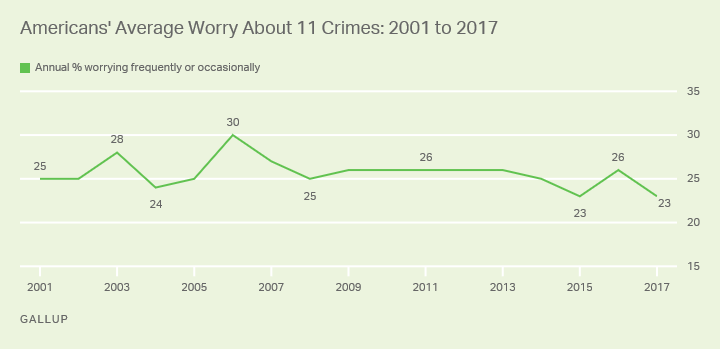
In recent years, Gallup has measured worry about cybercrimes, and -- not surprisingly -- concern about these crimes is high relative to the 11 more traditional crimes tracked over the longer period of time. A forthcoming story on gallup.com will examine these cybercrime results in detail.
Despite their levels of worry, Americans are very unlikely to report that they have actually been the victim of traditional crimes (excluding cybercrimes). About one in 10 say that within the last year, they or someone in their household has had money or property stolen, or had their home, car or other property vandalized. Very small percentages report having been a victim of the other crimes measured.
Bottom Line
Americans in recent years show no signs of becoming more concerned about any of a list of various crimes, and are actually less worried about walking alone in their neighborhood at night and being a victim of a home burglary or of terrorism than at most previous points in time.
Survey Methods
Results for this Gallup poll are based on telephone interviews conducted Oct. 5-11, 2017, with a random sample of 1,028 adults, aged 18 and older, living in all 50 U.S. states and the District of Columbia. For results based on the total sample of national adults, the margin of sampling error is ±4 percentage points at the 95% confidence level. All reported margins of sampling error include computed design effects for weighting.
Each sample of national adults includes a minimum quota of 70% cellphone respondents and 30% landline respondents, with additional minimum quotas by time zone within region. Landline and cellular telephone numbers are selected using random-digit-dial methods.
View survey methodology, complete question responses and trends.
Learn more about how the Gallup Poll Social Series works.
